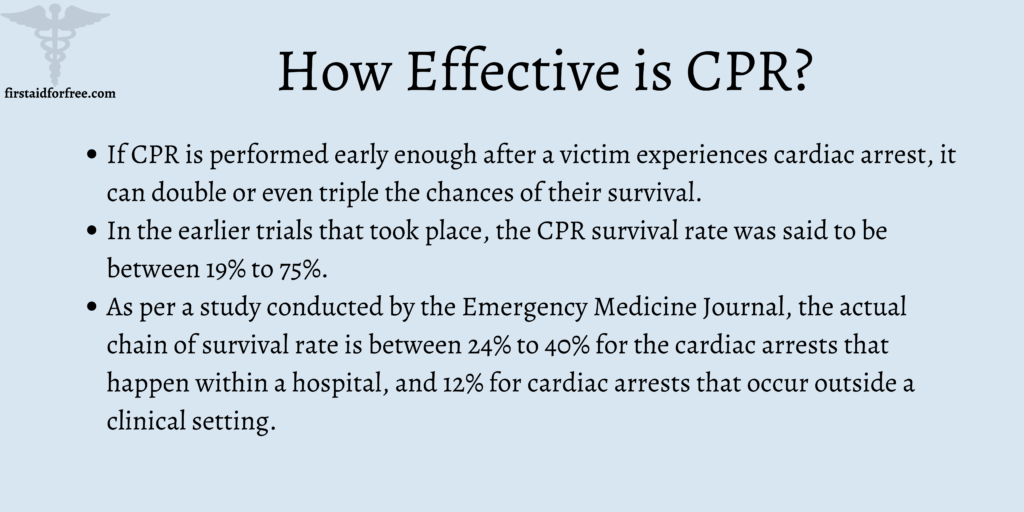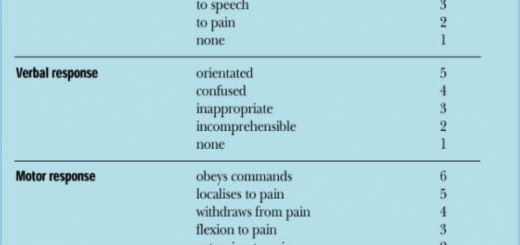CPR Success Rate: How Effective is CPR? {A Closer Look}
Did you know that cardiac arrest claims more lives globally than house fires, pneumonia, influenza, prostate cancer, breast cancer, colorectal cancer, HIV, auto accidents, and firearms combined?
About 90% of the out-of-hospital cardiac arrest victims don’t end up surviving. From the situations I’ve visualized closely, it’s evident that whenever CPR is administered immediately after cardiac arrest, it instantly increases the chances of a person’s survival.
There are a number of factors that determine the success rate of CPR, and it’s vital to know the various scenarios associated with CPR success rate before you decide to perform CPR on a person.
Have you ever wondered whether there is a difference between the CPR success rate between men and women? If not, then that question will be answered in this article where we will be discussing about the success rate of CPR, how important CPR is, and the factors that affect its success rate.
How Effective is CPR?
- If CPR is performed early enough after a victim experiences cardiac arrest, it can double or even triple the chances of their survival.
- In the earlier trials that took place, the CPR survival rate was said to be between 19% to 75%.
- As per a study conducted by the Emergency Medicine Journal, the actual chain of survival rate is between 24% to 40% for the cardiac arrests that happen within a hospital, and 12% for cardiac arrests that occur outside a clinical setting.
Factors That Affect CPR Success Rate
The following are the factors that affect the success rate of CPR:
EMS CPR and Bystander CPR
- EMS CPR is the CPR performed by those who are emergency medical responders. They are trained in a way such that they can perform CPR at a rate of 30:2 compressions to ventilation ratio.
- 100-200 compressions per minute is the recommended rate for chest compressions. Even when a person’s blood flow gets restored partially, it can increase their chances of survival.
- The rate of survival with bystander CPR is lower compared to CPR that is performed by a healthcare provider. It can, however, improve the victim’s chances of survival.
- Research suggests that when CPR is initiated soon after someone suffers cardiac arrest, it significantly increases the outcome for long-term survival.
Whether the Cardiac Arrest Had Any Witnesses
- As per a clinical trial that took place with 874 patients, the results suggested that a victim who suffered cardiac arrest without any witnesses had lower rates of survival in comparison to someone who had a bystander while they experienced cardiac arrest.
- 32% of cardiac arrest victims received CPR from bystanders. Still, the trial didn’t show early bystander CPR leading to increased chances of survival.
- Researchers found that the reason early bystander CPR didn’t affect the survival rate is because the CPR wasn’t performed correctly by the bystander. Therefore, it proves how important CPR training is and that it’s also vital to contact the paramedics as soon as possible when someone suffers cardiac arrest.
Where the CPR was Performed?
- The location of where the CPR was performed is yet another factor which determines the success rate of CPR.
- The survival rate in Western countries was found to be better than the success rate of CPR in Asia, North America, Oceania, and Europe.
- CPR certification courses have become popular in Asia only recently in comparison to Europe and the United States. Therefore, the quality of bystander CPR could be low there.
- Other non-western countries have lesser standards for CPR initiated by emergency medical personnel, which lowers the survival rates for out-of-hospital cardiac arrest in Asia.
CPR Success Rate by Gender
- The difference in the survival rate between genders with regard to CPR performed after a heart attack or cardiac arrest is quite unsettling.
- While 45% of men receive CPR assistance in public after experiencing sudden cardiac arrest, the percentage of women who receive CPR assistance in public following SCA is only 39%.
- Men have a 23% more chance of post-CPR survival as compared to women and are 1.23 times more likely to receive help and assistance from bystanders.
FAQs
Can you live a normal life after CPR?
Yes, it’s indeed possible to live a normal life after CPR if the person manages to survive.
How long does it take to recover from CPR?
The time it takes to recover after receiving CPR is based on the cause of the cardiac arrest and the time it takes for a person’s heart to beat again following the incident.
What are the signs of life after CPR?
The signs of life after CPR include any form of movement, pupillary response, or the person gasping or breathing normally.
What is the survival rate for out-of-hospital cardiac arrest in the US?
The overall survival rate for out-of-hospital cardiac arrest in the US is about 10%.
What is the primary purpose of CPR?
The primary purpose of CPR is to keep the blood circulation going and to get oxygen delivered to the body until specialist treatment is provided.
Conclusion
The following are the key takeaways from this article:
- When performed soon enough after a person suffers cardiac arrest, CPR can double or even triple the chances of a victim’s survival.
- Bystander CPR has lower rates of survival than CPR performed by emergency medical responders.
- The chances of survival for a cardiac arrest victim with a bystander witness is higher than someone who experiences cardiac arrest alone.
- The survival rate after CPR is higher in western countries.
- 45% of men receive CPR assistance in public as opposed to 39% of women.






